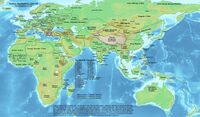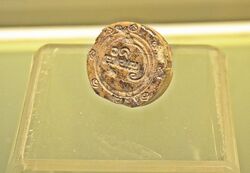Place:Rajahnate of Butuan
Ancient Butuan | |||||||||||||
|---|---|---|---|---|---|---|---|---|---|---|---|---|---|
| before 1001–1756 | |||||||||||||
| Capital | Centered in modern Butuan City | ||||||||||||
| Common languages | Butuanon,[1] Old Malay, other Visayan languages | ||||||||||||
| Religion | Hinduism, Buddhism and Animism | ||||||||||||
| Government | Monarchy | ||||||||||||
| History | |||||||||||||
• Established | before 1001 | ||||||||||||
• First historical reference by Song dynasty records | 1001 | ||||||||||||
• Integrated into the Spanish Empire after the last known monarch, Rajah Siagu, made a blood compact with Ferdinand Magellan | 1521 | ||||||||||||
• Area conquered by Spain | 1756 | ||||||||||||
| Currency | Piloncitos,[2] Barter rings | ||||||||||||
| |||||||||||||
| Today part of | |||||||||||||
The Rajahnate of Butuan (also called as Kingdom of Butuan; Butuanon: Gingharian hong Butuan, Template:Lang-ceb, Filipino: Kaharian ng Butuan/Karadyaan ng Butuan, Middle Chinese: 蒲端國, Buotuan-kwək̚ in Middle Chinese records) was an Indic polity centered on present Mindanao island in the modern city of Butuan in what is now the southern Philippines . It was known for its mining of gold, its gold products and its extensive trade network across the Nusantara area. The kingdom had trading relationships with the ancient civilizations of Japan , China , India , Indonesia, Persia, Cambodia and areas now comprised in Thailand.[3][4]
The balangay (large outrigger boats) that have been found along the east and west banks of the Libertad river (old Agusan River) have revealed much about Butuan's history. As a result, Butuan is considered to have been a major trading port in the Caraga region during the pre-colonial era.[5]
Historiography
Chinese records
Evidence indicates that Butuan was in contact with the Song dynasty of China by at least 1001 AD. The Chinese annal Song Shih recorded the first appearance of a Butuan tributary mission (Lijehan 李竾罕 and Jiaminan) at the Chinese Imperial Court on March 17, 1001 AD. Butuan (or "Buotuan" 蒲端 in Middle Chinese) around that time was a gold mining and trading center in northeastern Mindanao, known for manufacturing metal tools and weaponry, musical instruments, and gold jewelry.[6] The chief (or "king") of Butuan named Kiling[7] sent an envoy under I-hsu-han, with a formal memorial requesting equal status in court protocol with the Champa envoy. The request was denied later by the Imperial court, mainly because of favoritism over Champa.[8]
A new ruler with the Indianized name Sri Bata Shaja later succeeded in attaining diplomatic equality with Champa by sending the ambassador Likanhsieh. Likanhsieh shocked the Emperor Zhenzong by presenting a memorial engraved on a gold tablet, some white dragon (Bailong 白龍) camphor, Moluccan cloves, and a South Sea slave at the eve of an important ceremonial state sacrifice.[9] This display of irreverence sparked interests from China over the small Rajahnate and the diplomatic relations between the two polities reached its peak during the Yuan dynasty. Chinese records about the Rajahnate stopped after the reign of Rajah Siagu, the last independent Rajah of Butuan. He was formally subjugated into the Spanish Empire after he and his brother, Rajah Kolambu of Limasawa, made a blood compact with Ferdinand Magellan in 1521.
Excavated artifacts

Numerous jars have been found in the Butuan area that indicate the wealth of the kingdom and the existence of foreign traditions.[10] Some of these jars have been dated as follows:
- Sathing Phra (900–1100 AD)
- Haripunjaya (800–900 AD)
- Japanese (12th to 16th centuries AD)[11]
- Chinese (10th to 15th centuries AD)
- Khmer (9th to 10th centuries AD)
- Thai (14th to 15th centuries AD)
- Champa (11th to 13th centuries AD)
- Persian (9th to 10th centuries AD)
Artifacts have been recovered from within the vicinities of Ambangan Archeological Site in Libertad that attest to the historical accounts that Butuan traded with India,[12] Japan, Han Chinese, and Southeast Asian countries during these periods.[3]
Origins of the name
The name Butuan is believed to have existed long before the Spanish conquistadores arrived in the Philippine archipelago. One possible indication of this is a rhinoceros ivory seal with design carved in ancient Javanese or early Kawi script (used around the 10th century CE) which, according to a Dutch scholar, was deciphered as But-wan. Another account suggests the name derives from the word batuan, a mangosteen-related fruit common in Mindanao. Another alternative is that the name derives from Datu Bantuan, possibly a former datu of the region.[13]
Recorded monarchs
This section does not cite any external source. HandWiki requires at least one external source. See citing external sources. (March 2019) (Learn how and when to remove this template message) |
| The Royal Title of the Reigning Rajah | Events | From | Until |
|---|---|---|---|
| Kiling | The Embassy of I-shu-han (李竾罕) | 989[citation needed] | 1009[citation needed] |
| Sri Bata Shaja | Mission by Likanhsieh (李于燮) | 1011[citation needed] | ? |
| Rajah Siagu | Annexation by Ferdinand Magellan | ? | 1521 |
Modern commentary
Spanish chroniclers, when they stepped foot on Butuan, remarked that gold was so abundant that even houses were decorated with gold; "Pieces of gold, the size of walnuts and eggs are found by sifting the earth in the island of that king who came to our ships. All the dishes of that king are of gold and also some portion of his house as we were told by that king himself...He had a covering of silk on his head, and wore two large golden earrings fastened in his ears...At his side hung a dagger, the haft of which was somewhat long and all of gold, and its scabbard of carved wood. He had three spots of gold on every tooth, and his teeth appeared as if bound with gold." As written by Antonio Pigafetta on Rajah Siagu of Butuan during Magellan's voyage. Rajah Siagu was also a cousin of Rajah Humabon of the Rajahnate of Cebu, thus suggesting that the two Indianized kingdoms were in an alliance together with Hindu Kutai against the Islamic Sultanates of Maguindanao and Sulu.
Butuan was so rich in treasures that a museum curator, Florina H. Capistrano-Baker, stated that it was even richer than the more well-known western maritime kingdom of Srivijaya; "The astonishing quantities and impressive quality of gold treasures recovered in Butuan suggest that its flourishing port settlement played an until recently little-recognized role in early Southeast Asian trade. Surprisingly, the amount of gold discovered in Butuan far exceeds that found in Sumatra, where the much better known flourishing kingdom of Srivijaya is said to have been located."[14]
See also
- Butuan
- Balangay
- Dimasaua
- Golden Tara
- Butuanon people
- Indian cultural influences in early Philippine polities
References
- ↑ Fred S. Cabuang (September 6, 2007). "Saving Butuanon language". Archived from the original on August 30, 2008. https://web.archive.org/web/20080830070649/http://www.manilatimes.net/national/2007/sept/06/yehey/opinion/20070906opi7.html. Retrieved 2009-10-09.
- ↑ Ocampo, Ambeth R. (2011-08-30). "‘Piloncitos’ and the ‘Philippine golden age’". Philippine Daily Inquirer. https://opinion.inquirer.net/10991/%e2%80%98piloncitos%e2%80%99-and-the-%e2%80%98philippine-golden-age%e2%80%99.
- ↑ 3.0 3.1 "The Cultural Influences of India, China, Arabia, and Japan". 2010-07-14. http://www.philippinealmanac.com/2010/07/528/the-cultural-influences-of-india-china-arabia-and-japan.html.
- ↑ "Butuan Archeological Sites". https://whc.unesco.org/en/tentativelists/2071/.
- ↑ Lealiz, Sia (February 4, 2009). "Discovering the Ancient Kingdom of Butuan". The Philippine Star. http://www.philstar.com/ArticlePrinterFriendly.aspx?articleId=437256. Retrieved 2009-10-09.
- ↑ Abinales, Patricio N.; Amoroso, Donna J. (2005) (in en). State and Society in the Philippines. Rowman & Littlefield Publishers. p. 36. ISBN 9780742568723. https://books.google.com/books?id=cTx7AAAAQBAJ&source=gbs_navlinks_s&redir_esc=y. "Another Philippine place name appearing in Sung trade records is that of Butuan, a gold mining and trading center in northeastern Mindanao that sent its first tribute mission to China in 1001. From the tenth to the thirteenth centuries, Butuan was known for manufacturing metal tools and weaponry (blades, knives, and projectiles), musical instruments (bells, cymbals, and gongs), and gold jewelry (earrings, buckles, and rings)."
- ↑ Scott, William Henry (1989) (in English). Filipinos in China before 1500. China Studies Program, De La Salle University. https://www.worldcat.org/title/filipinos-in-china-before-1500/oclc/22641804. "Butuan seems to have attracted some notoriety. For four years, its King Kiling (Ch'i-ling) sent missions every year: on 3 October 1003, for example, Minister Lijihan and Assistant Minister Gaminan presented red parrots in addition to the usual native products like tortoise shell."
- ↑ Scott, William (1984). Prehispanic Source Materials: For the Study of Philippine History (revised ed.). Quezon City: New Day Publishers. p. 66. ISBN 9711002264.
- ↑ Song Shih Chapter 7 to 8
- ↑ Luna, Lillian (2004). MAPEH for Secondary Students. Art Books and History Books. St Bernadette Publications Inc.. ISBN 971-621-327-1.
- ↑ Manansala, Paul Kekai (2006-09-05). "Quests of the Dragon and Bird Clan: Luzon Jars (Glossary)". http://sambali.blogspot.com/2006/09/luzon-jars-glossary.html.
- ↑ Quirino, Karl (2010-09-01). "The Kingdom of Butuan". https://thebulwaganfoundation.wordpress.com/2010/09/01/the-kingdom-of-butuan/.
- ↑ "Historic Butuan". http://butuancity.info/about-butuan/92-historic-butuan.html. Retrieved 2009-10-09.
- ↑ "The Kingdom of Butuan". Asia Society New York. https://asiasociety.org/new-york/exhibitions/philippine-gold-treasures-forgotten-kingdoms.
External links





